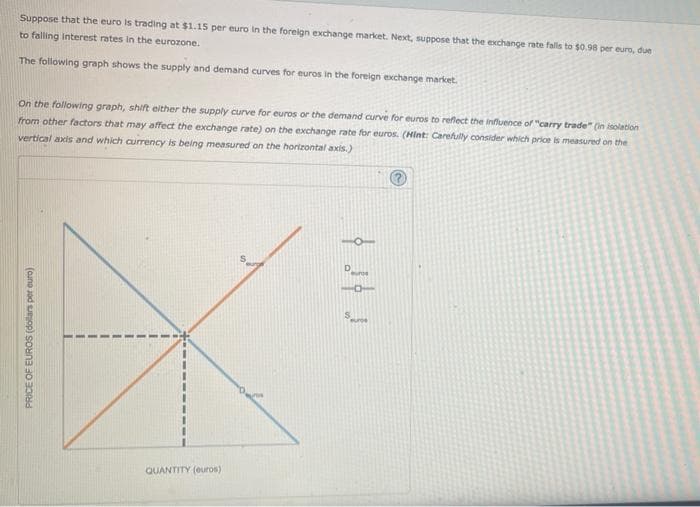Suppose that the euro is trading at $1.15 per euro in the foreign exchange market. Next, suppose that the exchange rate falls to $0.98 per euro, due to falling interest rates in the eurozone. The following graph shows the supply and demand curves for euros in the foreign exchange market. On the following graph, shift either the supply curve for euros or the demand curve for euros to reflect the influence of "carry trade" (in isolation from other factors that may affect the exchange rate) on the exchange rate for euros. (Hint: Carefully consider which price is measured on the vertical axis and which currency is being measured on the horizontal axis.) QUANTITY (euros) PRICE OF EUROS (dollars per euro)
Suppose that the euro is trading at $1.15 per euro in the foreign exchange market. Next, suppose that the exchange rate falls to $0.98 per euro, due to falling interest rates in the eurozone. The following graph shows the supply and demand curves for euros in the foreign exchange market. On the following graph, shift either the supply curve for euros or the demand curve for euros to reflect the influence of "carry trade" (in isolation from other factors that may affect the exchange rate) on the exchange rate for euros. (Hint: Carefully consider which price is measured on the vertical axis and which currency is being measured on the horizontal axis.) QUANTITY (euros) PRICE OF EUROS (dollars per euro)
Brief Principles of Macroeconomics (MindTap Course List)
8th Edition
ISBN:9781337091985
Author:N. Gregory Mankiw
Publisher:N. Gregory Mankiw
Chapter14: A Macroeconomic Theory Of The Open Economy
Section: Chapter Questions
Problem 7PA
Related questions
Question
7

Transcribed Image Text:Suppose that the euro is trading at $1.15 per euro in the foreign exchange market. Next, suppose that the exchange rate falls to $0.98 per euro, due
to falling interest rates in the eurozone.
The following graph shows the supply and demand curves for euros in the foreign exchange market.
On the following graph, shift either the supply curve for euros or the demand curve for euros to reflect the influence of "carry trade" (in isolation
from other factors that may affect the exchange rate) on the exchange rate for euros. (Hint: Carefully consider which price is measured on the
vertical axis and which currency is being measured on the horizontal axis.)
D
PRICE OF EUROS (dollars per euro)
QUANTITY (euros))
euros
-D-
Expert Solution
This question has been solved!
Explore an expertly crafted, step-by-step solution for a thorough understanding of key concepts.
This is a popular solution!
Trending now
This is a popular solution!
Step by step
Solved in 2 steps with 1 images

Knowledge Booster
Learn more about
Need a deep-dive on the concept behind this application? Look no further. Learn more about this topic, economics and related others by exploring similar questions and additional content below.Recommended textbooks for you

Brief Principles of Macroeconomics (MindTap Cours…
Economics
ISBN:
9781337091985
Author:
N. Gregory Mankiw
Publisher:
Cengage Learning

Principles of Economics (MindTap Course List)
Economics
ISBN:
9781305585126
Author:
N. Gregory Mankiw
Publisher:
Cengage Learning

Principles of Macroeconomics (MindTap Course List)
Economics
ISBN:
9781305971509
Author:
N. Gregory Mankiw
Publisher:
Cengage Learning

Brief Principles of Macroeconomics (MindTap Cours…
Economics
ISBN:
9781337091985
Author:
N. Gregory Mankiw
Publisher:
Cengage Learning

Principles of Economics (MindTap Course List)
Economics
ISBN:
9781305585126
Author:
N. Gregory Mankiw
Publisher:
Cengage Learning

Principles of Macroeconomics (MindTap Course List)
Economics
ISBN:
9781305971509
Author:
N. Gregory Mankiw
Publisher:
Cengage Learning


